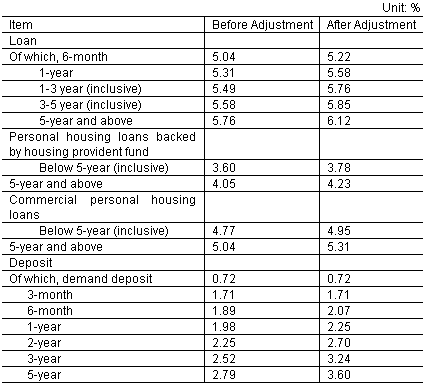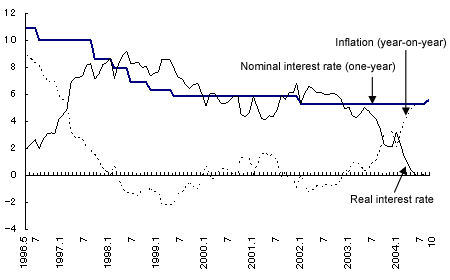On Oct. 28, China raised interest rates on bank loans and deposits, with the benchmark one-year lending rate up by 0.27 percentage point to 5.58% ( table ). Since last year, the Chinese economy has grown robustly thanks to strong investment. At the same time, however, signs of overheating have become increasingly clear. In an effort to cool the economy, the authorities have introduced various macroeconomic controls, including administrative measures toward selected industries, but up to now they had been reluctant to raise interest rates. However, consumer price inflation has exceeded 5% for four straight months since June to approach the benchmark one-year lending rate of 5.31% prevailing before the hike. At the same time, given the recent rise in oil prices, inflation will undoubtedly worsen and real interest rates on loans are set to fall into negative territory ( figure ). Furthermore, the United States has raised its benchmark short-term rate, the federal funds rate three times, by a total 0.75 percentage point since June, and pressure to revalue the yuan has eased as the spread between the two countries' interest rates has declined. The authorities, albeit belatedly, have raised rates in response. However, because the latest rise is small, further rate hikes can be expected in the future.
The government thus far has been very cautious toward raising interest rates for the following reasons. First, higher interest rates would hurt the profitability of state-owned enterprises, leading to an increase in bankruptcies and unemployment. Second, real estate prices, which have soared in recent years, would begin to fall, and the accompanying capital losses would dampen consumption. Third, because China's market mechanisms are still immature, investment does not respond quickly to changes in interest rates, and the investment-dampening effect of rising interest rates is expected to be limited. However, with an overheating economy, the current policy of maintaining artificially low interest rates may be unwise for a number of reasons.
Even after the interest rate hike, interest on one-year deposits remains at 2.25%, and when inflation is taken into account, real interest rates stand at roughly minus 3%. For depositors, this means that the purchasing power of their savings is declining at a rate of 3% a year, and this should affect consumption negatively.
In addition, given the limited means of hedging against inflation, liquidity looking for higher return is finding its way into the real estate market. And because the supply of land is strictly regulated as part of the government's macroeconomic controls, a real estate bubble is becoming increasingly apparent; raising interest rates swiftly is the most effective way of ensuring a soft landing. If interest rates are raised after the bubble expands further, the possibility of a hard landing will increase.
Furthermore, when interest rates are low, as they are at present, we see a disintermediation effect in which funds increasingly flow through channels other than banks. With these unregulated financial transactions rising, not only is the effectiveness of monetary policy reduced, but the soundness of the financial system would also be at risk.
On the other hand, if the authorities try to put the brakes on investment through administrative measures rather than higher interest rates, their efforts to shift toward a more market-oriented system in China will be undercut. For example, industries that are judged to have overheated such as steel, aluminum and cement have traditionally been monopolized by state-owned enterprises and profits in these sectors are high, and as a result, many private enterprises have tried to enter these industries. Implementing policies of restraint would put these private firms directly in the line of fire, damaging the efficiency and equity that are the basic principles of a market economy. On the other hand, if the authorities try to prolong the lives of inefficient state-owned enterprises by keeping interest rates low, the problem of moral hazard will be aggravated and investment efficiency will remain low.
In order to correct such distortions, the authorities should immediately shift their policies of restraint from direct administrative measures to indirect measures such as raising interest rates. We can see the recent rate increase as a first step in that direction. At the same time, it is also safe to assume that further rate hikes are in store because the latest increase is too small given current domestic inflation and interest rate levels in the U.S.

(Note)Announced on Oct. 28, effective from Oct.29
(Source)People's Bank of China

(Source)Based on Bloomberg and CEIC data


